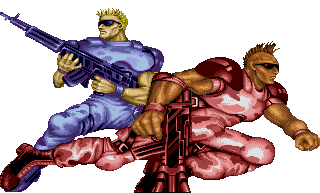 Forgotten Worlds received a Genesis port shortly after the console launched in 1989, and gamers were impressed with the two-player shmup action. It wasn’t 100% accurate, but the approximation was enough to satisfy fans. Soon afterward, the game was released on the TurboGrafx-16 Super CD-ROM2, to surprisingly little fanfare. Despite some problems, it featured all of the arcade levels and more faithful graphics, as well as one hell of a great soundtrack.. Unfortunately, the console’s small user base caused it to be lost amid all the fanfare of the SNES debut and the the upcoming console war.
Forgotten Worlds received a Genesis port shortly after the console launched in 1989, and gamers were impressed with the two-player shmup action. It wasn’t 100% accurate, but the approximation was enough to satisfy fans. Soon afterward, the game was released on the TurboGrafx-16 Super CD-ROM2, to surprisingly little fanfare. Despite some problems, it featured all of the arcade levels and more faithful graphics, as well as one hell of a great soundtrack.. Unfortunately, the console’s small user base caused it to be lost amid all the fanfare of the SNES debut and the the upcoming console war.
Considering the technical advantages the Super CD-ROM2 had over the stock Genesis, it was surprising to see that Forgotten Worlds wasn’t spot-on. The increased memory and color palate should have technically been enough for NEC’s underachiever to take on the competition, but poor marketing and a lack of third party support made it the first casualty of the 16-bit era.
The Genesis, on the other hand, was picking up steam in America, though the initial lack of arcade hits from companies other than Sega forced publishers to sometimes release titles that weren’t as enjoyable as some of the games appearing on the still-supreme NES. We have Nintendo’s licensing agreements to thank for that, and while Capcom wasn’t able to directly release Forgotten Worlds, it was able to circumvent their licensing shackles and allow Sega to handle the game themselves. This was a practice used several times over the first few years of the Genesis’s life span, for titles such as Ghouls ‘N Ghosts, Strider, and MERCS. In this manner, Capcom was able to support competing platforms and bring some of their more advanced games to the Genesis.
The Differences
Presentation: At first glance, you might consider that the Super CD-ROM2 would instantly be superior. That, strangely enough, is not the case. In fact, it’s far from it. NEC Avenue retained all the levels from the arcade game, whereas a few were cut out on the Genesis. Had Sega gone with a larger cartridge, it might have been a whole other story, but as it is, the difference is quite notable. On the Genesis, Forgotten Worlds zips by almost too fast, and before you know it, you’re at the final boss. I’d wager that at least a good 10-15 minutes have been shaved off, and the whole experience is much too short now.
On the Super CD-ROM2, however, the longer levels are offset by a great increase in difficulty. Forgotten Worlds is much harder here, and it can sometimes be more frustrating than it should be due to the gameplay (see below). This is compounded by the fact that the game only supports one player. Half the fun of playing it in arcades was being able to battle alongside a friend. Now, players must fly solo. A second person can control the satellite by way of a code, but how fun does that sound? Both characters appear in the cut scenes, and I don’t recall the satellites getting in on any of the plot. And since it’s single-player, the added bonus of those little weapon-enhancing sparks that appeared when the two Nameless Ones were in proximity of each other are gone.
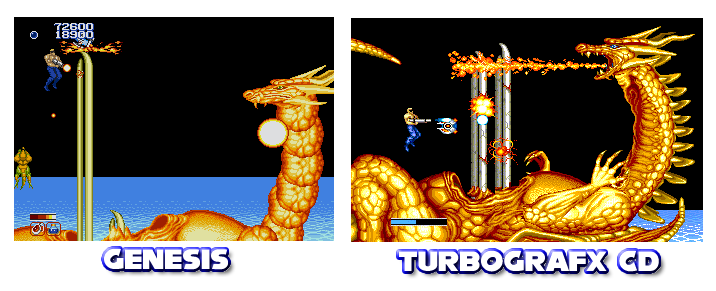
Edge: Draw
Graphics: Both versions tried hard to retain the same style and look of the arcade original, and this is one area where the Super CD-ROM2 easily overtakes its cartridge rival. The visuals are quite a step up from the Genesis version, but still aren’t arcade-perfect. That’s no big deal, when you think about the state of arcade ports during the early 1990s. Anyone who was a fan of the coin-op would find little to complain about with the Super CD-ROM2 game, and that was more than enough for the time. The cut scenes are almost all intact as well, and are much more numerous than they are on the Genesis.
On cartridge, Forgotten Worlds is considerably toned-down visually, especially in the backgrounds. Where certain parts were originally lush with art and scenery, they are now mere black screens. The lack of colors really hurts what detail is there, and its blatantly obvious that severe compromises had to be made here. There is considerably better use of parallax scrolling, and I suppose it helps to compensate for the drab backdrops, but why did they have to be mutually exclusive? Again, why didn’t Sega just up the cartridge size? Why strip the game of detail as well as stages just to fit into a four meg cart?
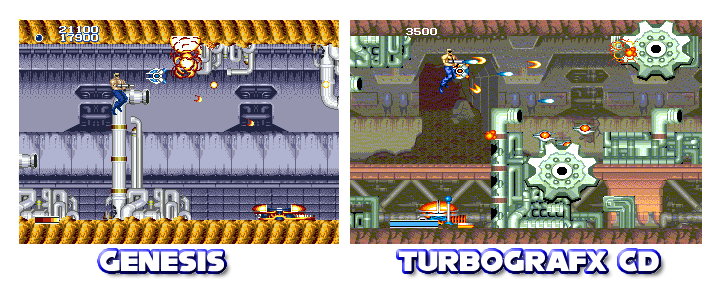
Edge: Super CD-ROM2
Sound/Music: As you might guess, this area is simply no contest; the Super CD-ROM2 is leagues ahead. The audio is brilliant, to be sure, and I’m certain that anyone with a copy of the game has listened to it in their CD player often; it truly is a great soundtrack. The voices aren’t as clear as they should be…wait, that’s an understatement. The voice overs are so muffled an monotone that they’re hilarious. Imagine Mr. Spock pointing a gun at you and saying you cannot stop me with paramecium alone! Not the most convincing scenario, is it? Still, I guess I should be glad that they’ve been included at all, and I have to commend NEC Avenue for trying to maintain as much of the audio as possible.
Things are a whole different story on the Genesis. The sound has suffered greatly. The epic soundtrack is muted and the voice overs — campy as they were — are gone. Thankfully, the sound effects haven’t suffered as much. That’s cold comfort though, since everything else got slammed in the nuts. Seriously, after hearing the glory that was the Super CD-Rom2’s redbook soundtrack, I’m almost offended by the Genesis renditions. This is another case of the Genesis’s limited cartridge space simply being unable to compete with the massive storage abilities of the CD.
Genesis Stage 1 Theme: (MP3, 1.46 megs) Super CD-ROM2 Stage 1 Theme (MP3, 1.16 megs)
Edge: Super CD-ROM2
Gameplay: Ah the most important category of all, and the one where the Genesis takes a huge dump on the Super CD-ROM2 from a great height. Virtually everyone I know upgraded to the sexy six-button pad when it was released, but the stock three-button controller did a commendable job during its run. I heard people complained about playing Forgotten Worlds with it, whining about cramps and all. They should have considered themselves lucky. U.S. TurboGrafx owners had to make due with their woefully inadequate two-button pad, whereas lucky importers received a copy bundled with a neat three-button controller. As hard as some found it on the Genesis, playing with the Turbo’s stock pad was brutally unintuitive. You had to use the Run and I buttons to rotate, which was a very, very bad idea. Think about that for a second. You were forced to hold down to fire and rotate with the buttons on either side. Shades of Carpal Tunnel Syndrome! Mixed with the additional levels and increased difficulty, Forgotten Worlds quickly became a test for hand stamina, with few people coming out on top. NEC Avenue eventually remedied the problem… in Japan, by releasing a much-improved six-button controller, but incredibly never brought it stateside. You can probably imagine just how much this helped the Super CD’s grim situation in America, and rightly so.
With the horrible button layout working against it on CD, Forgotten Worlds is infinitely more playable on the Genesis. This problem becomes moot, of course — if you import a NEC Avenue pad — which will set you back about $25-30, but think about that for a second: you have to import another controller just to make the game playable. Tsk, tsk, tsk NEC Avenue!
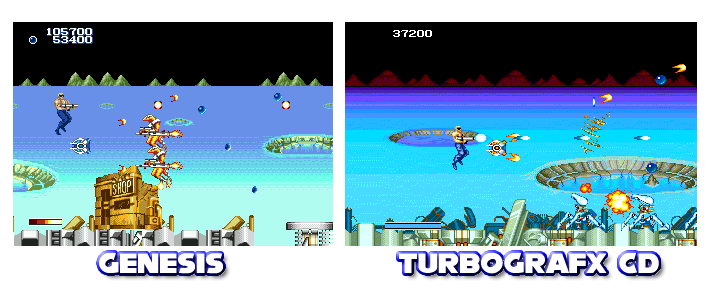
Edge: Genesis
Other: Aside from the differences noted above, there really aren’t any other significant changes. Both versions have all the weapons and upgrades, and the hidden power ups remain. I guess with the tremendous contrasts in visuals and gameplay, Sega and NEC felt it best to keep everything else.
I do have to admit, that even though it has the edge in several categories, the Super CD-ROM2 should have done much better than it did. Forgotten Worlds arrived on it a full two years after appearing on the Genesis, and on CD-ROM to boot. It should have trounced the Genesis cart mercilessly. There’s simply no excuse for NEC Avenue’s misuse of the technological advantage they had here.
By the same token, I must note Sega’s questionable decision to go with a smaller cart size. The resulting compromises watered down an arcade classic considerably, and only its greater availability, solid gameplay, and two-player cooperative action save it.
A big finger wave to both companies here.
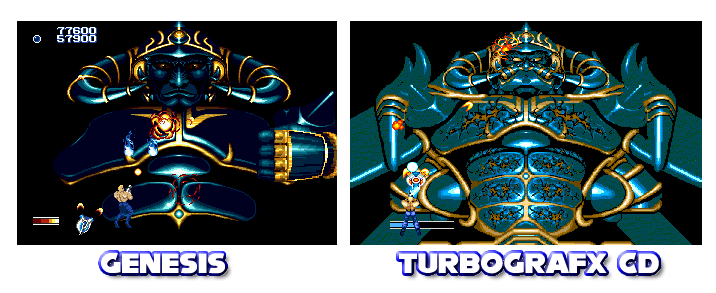
Edge: Draw
Final Assessment
If you own both consoles, you probably own more than one copy of Forgotten Worlds. The Super CD-ROM2 version wins out and is a worthy investment because of its retention of all the arcade levels and incredible musical score. A NEC Avenue pad negates the gameplay problems, but you still can’t really play two-player, and the steep difficulty might be a problem. That’s when it’s a good idea to have the Genesis port. You can bring along a friend, or play right through by yourself. Either game is fine on its own, but I suspect that more people have the Genesis cartridge due to its low cost and availability.
Modern gamers can forgo all these problems by purchasing the excellent Capcom Classics Collection Vol.1, which includes a perfect rendition of the arcade game, two-player option and all. There’s no excuse not to have this great shmup, and thankfully there’s something for every taste.

Recent Comments